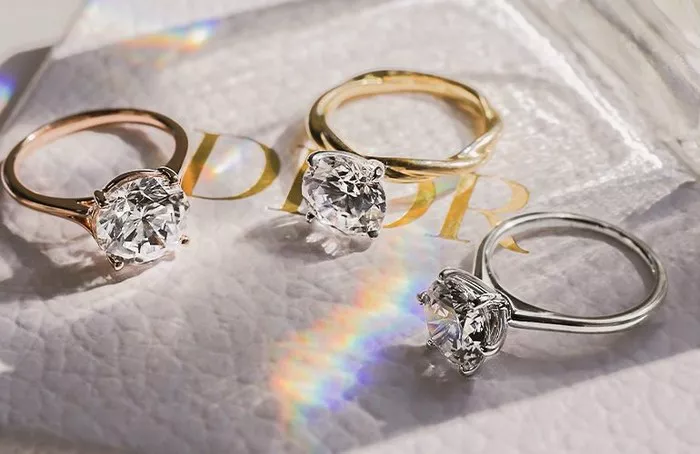When it comes to purchasing a diamond ring, particularly one with a single carat diamond, understanding the factors that influence its price is essential. The value of a diamond is not determined by its size alone; rather, it is a combination of several factors commonly referred to as the “4Cs” of diamonds: Carat Weight, Cut, Color, and Clarity. These characteristics significantly impact the price of a diamond, and each one plays a crucial role in determining the overall value of the stone.
The 4Cs of Diamonds
Carat Weight
Carat weight refers to the size of the diamond. One carat is equivalent to 0.2 grams, and it is one of the most significant factors in determining a diamond’s price. Generally, the larger the diamond, the more expensive it will be. However, the value is not solely based on size. A diamond’s price increases exponentially with the weight, meaning that a two-carat diamond could be much more expensive than two one-carat diamonds of similar quality.
Cut
The cut of a diamond affects how well it reflects light and, therefore, its brilliance. A well-cut diamond will sparkle more, while a poorly cut diamond may appear dull or lackluster, even if it has good color and clarity. The cut is often considered the most important of the 4Cs because it directly influences the overall appearance of the diamond. The better the cut, the more light is reflected, resulting in greater brilliance and a higher value.
Color
Diamonds are graded on a color scale from D to Z, with D being completely colorless and Z indicating a diamond with noticeable yellow or brown hues. Colorless diamonds (grades D-F) are the most valuable because they are rare, while diamonds with a yellow or brown tint are less valuable. The difference in color can be subtle, but it plays a crucial role in a diamond’s appearance and price.
Clarity
Clarity refers to the presence of internal or external imperfections, known as inclusions and blemishes. Diamonds with fewer inclusions and blemishes are considered to have higher clarity, which increases their value. Clarity is graded on a scale from Flawless (no inclusions or blemishes visible under 10x magnification) to Included (inclusions visible to the naked eye). The fewer imperfections a diamond has, the more valuable it is.
Price Range for a One Carat Diamond
The price of a one-carat diamond can vary widely depending on the combination of the 4Cs. Generally, the price of a one-carat diamond falls within the range of $1,900 to $16,000 or more. The price at the lower end of the range would be for diamonds with lower clarity, color, or less optimal cut, while the higher-end diamonds would have excellent or ideal grades in these areas.
For example:
A one-carat diamond with a grade of G color, VS2 clarity, and a Good cut might cost around $4,000 to $6,000.
A diamond of the same carat weight but with a D color, Flawless clarity, and Excellent cut could easily exceed $15,000 to $16,000.
Factors Influencing Price
Market Demand
Market trends and consumer demand play an important role in diamond pricing. Economic factors, trends in jewelry preferences, and global demand for diamonds can influence prices. For instance, during peak wedding seasons or holidays, demand for engagement rings can push prices higher.
Certification
Diamonds certified by a reputable gemological laboratory, such as the Gemological Institute of America (GIA) or the American Gem Society (AGS), provide assurance of the diamond’s authenticity and quality. A certified diamond can fetch a higher price because its value is guaranteed by an expert institution, offering consumers peace of mind.
Tips for Getting the Best Value
Choosing the Right Diamond
When shopping for a one-carat diamond ring, aim for a balanced combination of the 4Cs to get the best value for your budget. While you may want an ideal cut or flawless clarity, it may be worth compromising slightly on color or clarity to secure a diamond that offers a more attractive price without sacrificing too much visual appeal.
Comparing Prices
It’s wise to shop around and compare prices from multiple retailers. Diamond prices can differ significantly between stores, even for stones with similar characteristics. Additionally, consider purchasing during sales events, as retailers may offer substantial discounts during special promotions or holiday seasons.
Additional Considerations
Fluorescence
Fluorescence occurs when a diamond emits a soft glow under ultraviolet (UV) light. While this characteristic is not necessarily a negative one, diamonds with strong fluorescence may appear slightly cloudy or less brilliant in natural light, which can affect their value. Generally, diamonds with strong fluorescence are priced lower than those with no fluorescence, though this is largely a matter of personal preference.
Personal Preferences
Ultimately, the most important factor when choosing a one-carat diamond ring is your personal preferences and budget. Some buyers may prioritize a higher cut or clarity grade, while others may be willing to accept a lower grade in exchange for a larger stone or more favorable color. It’s important to find a balance that suits your aesthetic preferences and financial constraints.
Conclusion
The value of a one-carat diamond ring can vary widely depending on the combination of the 4Cs: Carat, Cut, Color, and Clarity. While larger diamonds tend to cost more, it is essential to consider the overall quality of the diamond rather than just its size. By understanding how each of the 4Cs impacts price and appearance, buyers can make informed decisions and find a diamond that offers the best value for their needs and preferences. Always ensure that the diamond is certified by a reputable gemological laboratory, and take time to compare prices to ensure you’re getting the best deal.
Related topics:

